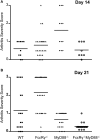Dual role for Fcγ receptors in host defense and disease in Borrelia burgdorferi-infected mice
- PMID: 24967215
- PMCID: PMC4052197
- DOI: 10.3389/fcimb.2014.00075
Dual role for Fcγ receptors in host defense and disease in Borrelia burgdorferi-infected mice
Abstract
Arthritis in mice infected with the Lyme disease spirochete, Borrelia burgdorferi, results from the influx of innate immune cells responding to the pathogen in the joint and is influenced in part by mouse genetics. Production of inflammatory cytokines by innate immune cells in vitro is largely mediated by Toll-like receptor (TLR) interaction with Borrelia lipoproteins, yet surprisingly mice deficient in TLR2 or the TLR signaling molecule MyD88 still develop arthritis comparable to that seen in wild type mice after B. burgdorferi infection. These findings suggest that other, MyD88-independent inflammatory pathways can contribute to arthritis expression. Clearance of B. burgdorferi is dependent on the production of specific antibody and phagocytosis of the organism. As Fc receptors (FcγR) are important for IgG-mediated clearance of immune complexes and opsonized particles by phagocytes, we examined the role that FcγR play in host defense and disease in B. burgdorferi-infected mice. B. burgdorferi-infected mice deficient in the Fc receptor common gamma chain (FcεRγ(-/-) mice) harbored ~10 fold more spirochetes than similarly infected wild type mice, and this was associated with a transient increase in arthritis severity. While the elevated pathogen burdens seen in B. burgdorferi-infected MyD88(-/-) mice were not affected by concomitant deficiency in FcγR, arthritis was reduced in FcεRγ(-/-) MyD88(-/-) mice in comparison to wild type or single knockout mice. Gene expression analysis from infected joints demonstrated that absence of both MyD88 and FcγR lowers mRNA levels of proteins involved in inflammation, including Cxcl1 (KC), Xcr1 (Gpr5), IL-1beta, and C reactive protein. Taken together, our results demonstrate a role for FcγR-mediated immunity in limiting pathogen burden and arthritis in mice during the acute phase of B. burgdorferi infection, and further suggest that this pathway contributes to the arthritis that develops in B. burgdorferi-infected MyD88(-/-) mice.
Keywords: Borrelia burgdorferi; Fc receptor; Lyme disease; MyD88; arthritis; mice; toll-like receptors.
Figures




Similar articles
-
Myeloid differentiation antigen 88 deficiency impairs pathogen clearance but does not alter inflammation in Borrelia burgdorferi-infected mice.Infect Immun. 2004 Jun;72(6):3195-203. doi: 10.1128/IAI.72.6.3195-3203.2004. Infect Immun. 2004. PMID: 15155621 Free PMC article.
-
MyD88 plays a unique role in host defense but not arthritis development in Lyme disease.J Immunol. 2004 Aug 1;173(3):2003-10. doi: 10.4049/jimmunol.173.3.2003. J Immunol. 2004. PMID: 15265935
-
Toll-like receptor 2 is required for innate, but not acquired, host defense to Borrelia burgdorferi.J Immunol. 2002 Jan 1;168(1):348-55. doi: 10.4049/jimmunol.168.1.348. J Immunol. 2002. PMID: 11751980
-
Mechanisms of Borrelia burgdorferi internalization and intracellular innate immune signaling.Front Cell Infect Microbiol. 2014 Dec 15;4:175. doi: 10.3389/fcimb.2014.00175. eCollection 2014. Front Cell Infect Microbiol. 2014. PMID: 25566512 Free PMC article. Review.
-
Infectious arthritis and immune dysregulation: lessons from Lyme disease.Curr Opin Rheumatol. 2010 Jul;22(4):451-5. doi: 10.1097/BOR.0b013e328338f73f. Curr Opin Rheumatol. 2010. PMID: 20375899 Review.
Cited by
-
Borrelia burgdorferi peptidoglycan is a persistent antigen in patients with Lyme arthritis.Proc Natl Acad Sci U S A. 2019 Jul 2;116(27):13498-13507. doi: 10.1073/pnas.1904170116. Epub 2019 Jun 17. Proc Natl Acad Sci U S A. 2019. PMID: 31209025 Free PMC article.
-
Lyme disease: recent advances and perspectives.Front Cell Infect Microbiol. 2015 Apr 1;5:27. doi: 10.3389/fcimb.2015.00027. eCollection 2015. Front Cell Infect Microbiol. 2015. PMID: 25883907 Free PMC article. No abstract available.
-
Phagocytic Receptors Activate Syk and Src Signaling during Borrelia burgdorferi Phagocytosis.Infect Immun. 2017 Sep 20;85(10):e00004-17. doi: 10.1128/IAI.00004-17. Print 2017 Oct. Infect Immun. 2017. PMID: 28717031 Free PMC article.
-
Selenoprotein K regulation of palmitoylation and calpain cleavage of ASAP2 is required for efficient FcγR-mediated phagocytosis.J Leukoc Biol. 2017 Feb;101(2):439-448. doi: 10.1189/jlb.2A0316-156RR. Epub 2016 Sep 6. J Leukoc Biol. 2017. PMID: 27601625 Free PMC article.
-
A human secretome library screen reveals a role for Peptidoglycan Recognition Protein 1 in Lyme borreliosis.PLoS Pathog. 2020 Nov 11;16(11):e1009030. doi: 10.1371/journal.ppat.1009030. eCollection 2020 Nov. PLoS Pathog. 2020. PMID: 33175909 Free PMC article.
References
-
- Barthold S. W., de Souza M., Fikrig E., Persing D. H. (1992). Lyme borreliosis in the laboratory mouse, in Lyme Disease: Molecular and Immunologic Approaches. Current Communications in Cell & Molecular Biology, ed Schutzer S. E. (New York, NY: Cold Spring Harbor Press; ), 223–242
-
- Baudino L., Nimmerjahn F., Azeredo da Silveira S., Martinez-Soria E., Saito T., Carroll M., et al. (2008). Differential contribution of three activating IgG Fc receptors (FcgammaRI, FcgammaRIII, and FcgammaRIV) to IgG2a- and IgG2b-induced autoimmune hemolytic anemia in mice. J. Immunol. 180, 1948–1953 10.4049/jimmunol.180.3.1948 - DOI - PubMed
Publication types
MeSH terms
Substances
Grants and funding
LinkOut - more resources
Full Text Sources
Other Literature Sources
Medical
Research Materials

